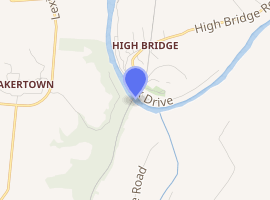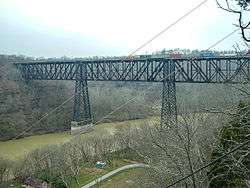High Bridge of Kentucky
High Bridge is a railroad bridge crossing the Kentucky River Palisades, that rises approximately 275 feet from the river below and connects Jessamine and Mercer counties in Kentucky. Formally dedicated in 1879,[1] it is the first cantilever bridge constructed in the United States. It has a three-span continuous under-deck truss used by Norfolk Southern Railway to carry trains between Lexington and Danville. It has been designated as a National Civil Engineering Landmark.[2]
High Bridge | |
|---|---|
 An aerial view of the High Bridge | |
| Coordinates | 37.8168°N 84.7200°W |
| Carries | Railroad |
| Crosses | Kentucky River |
| Locale | Jessamine & Mercer Counties, Kentucky, United States |
| Characteristics | |
| Design | Truss |
| Total length | 1,125 feet (343 m) |
| Height | 275 feet (84 m) (or 308 ft.) |
| History | |
| Designer | Charles Shaler Smith (1876) Gustav Lindenthal (1911) |
| Opened | 1877 |

| |
History
In 1851, the Lexington & Danville Railroad, with Julius Adams as Chief Engineer, retained John A. Roebling to build a railroad suspension bridge across the Kentucky River for a line connecting Lexington and Danville, Kentucky west of the intersection of the Dix and Kentucky Rivers.[1] In 1855, the company ran out of money and the project was resumed by Cincinnati Southern Railroad in 1873 following a proposal by C. Shaler Smith for a cantilever design using stone towers designed[1] by John A. Roebling (who designed the Brooklyn Bridge).
The bridge was erected using the cantilever design with a three-span continuous under-deck truss and opened in 1877 on the Cincinnati Southern Railway.[3] It was 275 feet (84 m) tall and 1,125 feet (343 m) long: the tallest bridge above a navigable waterway in North America and the tallest railroad bridge in the world until the early 20th century. Construction was completed using 3,654,280 pounds of iron at a total cost of $404,373.31.[1] In 1879 President Rutherford B. Hayes and Gen. William Tecumseh Sherman attended the dedication.[4]
Around 1908, Kentucky River High Bridge and the surrounding area was a popular destination for local Kentucky artist Paul Sawyier. Sawyier made many friends living in the area and the landscape was the subject of many of his famous paintings. In addition to making many friends with local residents, he met the love of his life, Mary Thomas (Mayme) Bull during her travels to the Kentucky River area. She became the subject of one of his paintings in 1908, ‘Portrait of Mayme Bull in River Landscape’.[5]
After years of heavy railroad use, the bridge was rebuilt by Gustav Lindenthal in 1911. Lindenthal reinforced the foundations and rebuilt the bridge around the original structure. To keep railroad traffic flowing, the track deck was raised by 30 feet during construction and a temporary trestle was constructed.[6] In 1929, an additional set of tracks was built to accommodate increased railroad traffic and the original limestone towers were removed.
The bridge is still accessible by Kentucky State Route 29.[6] In 2005 the state and county jointly reopened a park near the bridge (which had been closed since the mid 1960s) at the top of the palisades above the river. It included a restored open air dance pavilion, first used in the 19th century; as well as a new playground, picnic area, and viewing platform that overlooks the bridge and river's edge from the top of the palisades.[7]
References

- Griggs, Frank (August 2015). "Kentucky River High Bridge". Structure Magazine.
- Griggs, Francis (2002). "Kentucky River High Bridge". Journal of Bridge Engineering. 7 (2): 73–84. doi:10.1061/(ASCE)1084-0702(2002)7:2(73).
- Rennick, Robert M. (1987). Kentucky Place Names. University Press of Kentucky. p. 139. ISBN 0813126312. Retrieved 2013-04-28.
- "Engineering Timelines - The Forth Rail Bridge - The Cantilever Principle". Archived from the original on 2008-05-11. Retrieved 2008-06-20.
- Poe, Amy (n.d.). "High Bridge". Explore KY History. Retrieved April 1, 2019.
- Powell, Tim (n.d.). "History of High Bridge". World Tim Zone. Retrieved April 21, 2019.
- "High Bridge". University of Kentucky. Retrieved 2009-06-17.
External links

- Historic American Engineering Record (HAER) No. KY-37, "High Bridge"